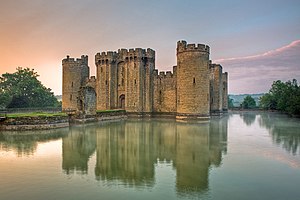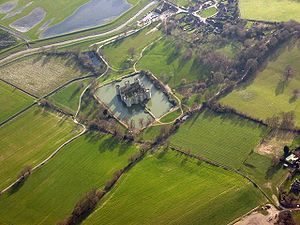Bodiam Castle
Bodiam Castle is a 14th-century moated castle near Robertsbridge in East Sussex, England. It was built in 1385 by Sir Edward Dalyngrigge, a former knight of Edward III, with the permission of Richard II, ostensibly to defend the area against French invasion during the Hundred Years' War. Of quadrangular plan, Bodiam Castle has no keep, having its various chambers built around the outer defensive walls and inner courts. Its corners and entrance are marked by towers, and topped by crenellations. Its structure, details and situation in an artificial watery landscape indicate that display was an important aspect of the castle's design as well as defence. It was the home of the Dalyngrigge family and the centre of the manor of Bodiam.
Possession of Bodiam Castle passed through several generations of Dalyngrigges, until their line became extinct, when the castle passed by marriage to the Lewknor family. During the Wars of the Roses, Sir Thomas Lewknor supported the House of Lancaster, and whenRichard III of the House of York became king in 1483, a force was despatched to besiege Bodiam Castle. It is unrecorded whether the siege went ahead, but it is thought that Bodiam was surrendered without much resistance. The castle was confiscated, but returned to the Lewknors when Henry VII of the House of Lancaster became king in 1485. Descendants of the Lewknors owned the castle until at least the 16th century.
By the start of the English Civil War in 1641, Bodiam Castle was in the possession of John Tufton. He supported the Royalist cause, and sold the castle to help pay fines levied against him by Parliament. The castle was subsequently dismantled, and was left as a picturesque ruin until its purchase by John Fuller in 1829. Under his auspices, the castle was partially restored before being sold to George Cubitt, 1st Baron Ashcombe, and later to Lord Curzon, both of whom undertook further restoration work. The castle is protected as a Grade I listed building and Scheduled Monument. It has been owned by The National Trust since 1925, donated by Lord Curzon on his death, and is open to the public.
Construction and use[edit]
... Know that of our special grace we have granted and given license on behalf of ourselves and our heirs, so far as in us lies, to our beloved and faithful Edward Dalyngrigge Knight, that he may strengthen with a wall of stone and lime, and crenellate and may construct and make into a Castle his manor house of Bodyham, near the sea, in the County of Sussex, for the defence of the adjacent country, and the resistance to our enemies ... In witness of which etc. The King at Westminster 20 October.
—Excerpt from the license to crenellate allowing Edward Dalyngrigge to build a castle from the Patent Rolls of 1385–89
Dalyngrigge's licence from Richard II permitted him to refortify his existing manor house, but instead he chose a fresh site to build a castle on. Construction was completed in one phase, and most of the castle is in the same architectural style. Archaeologist David Thackray has deduced from this that Bodiam Castle was built quickly, probably because of the threat from the French. Stone castles were usually time-consuming and expensive to build, often costing thousands of pounds. Dalyngrigge was Captain of the port of Brest in France from 1386 to 1387, and as a result was probably absent for the first years of the castle's construction. It replaced the old manor house as Dalyngrigge's main residence and the administrative centre of the manor. It is not recorded when Bodiam Castle was completed, but Thackray suggests that it was before 1392; Dalyngrigge did not have long to spend in the completed castle, as he was dead by 1395.
Edward's estates, including the castle, were inherited by his son, John Dalyngrigge. Like his father, John enjoyed the favour of the king and was described as the "King's Knight"; in 1400 he was granted an annual allowance of 100 marks by the king. He died on 27 September 1408; his will ensured that his property belonged to his widow, Alice. John and Alice had no children, so on her death in 1443 the estates and castle were passed on to Richard Dalyngrigge, John's cousin. Richard died without issue, so in accordance with John's will the estates passed on to Richard's sister Philippa in 1470. She was married to Sir Thomas Lewknor, from a prominent Sussex family who owned land all over the country.
Sir Thomas Lewknor was a supporter of the House of Lancaster during the Wars of the Roses, which began in 1455. When Richard of the House of York ascended to the throne as Richard III in 1483, Lewknor was accused of treason and of raising men-at-arms in southeast England. In November 1483, Lewknor's uncle and Thomas Howard, the Earl of Surrey, were given permission to levy men and besiege Bodiam Castle, where Lewknor was based. It is not recorded whether the siege went ahead, and Thackray suggests that Lewknor surrendered without much resistance. His property was confiscated, and Nicholas Rigby was made constable of the castle. On Henry VII's accession to the English throne the attainder was revoked, and Bodiam Castle was returned to Lewknor. However, not all of the surrounding land was returned to the family until 1542. Possession of Bodiam Castle passed through several generations of the Lewknor family. Although the inheritance of the castle can be traced through the 16th and 17th centuries, there is little to indicate how it was used in this period, or if the family spent much time in it.
Following Sir Roger Lewknor's death in 1543, his estates were divided among his descendants, and the castle and manor were split. John Levett of Salehurst purchased the castle in 1588. In 1623, most of the estates of Bodiam were bought by Sir Nicholas Tufton, later Earl of Thanet. His son,John Tufton, 2nd Earl of Thanet, inherited Nicholas's property on his father's death in 1631; it was John Tufton who reunited possession of castle and manor when he bought Bodiam Castle in 1639. John Tufton was a supporter of the Royalist cause during the English Civil War, and led an attack on Lewes, and was involved in a Royalist defeat at Haywards Heath. Parliament confiscated some of his lands in 1643, and more in 1644, as well as fining him £9,000 (£1.3 million as of 2008). To help pay his fine, Tufton sold Bodiam Castle for £6,000 (£860,000 as of 2008) in March 1644 to Nathaniel Powell, a Parliamentarian.





No comments:
Post a Comment